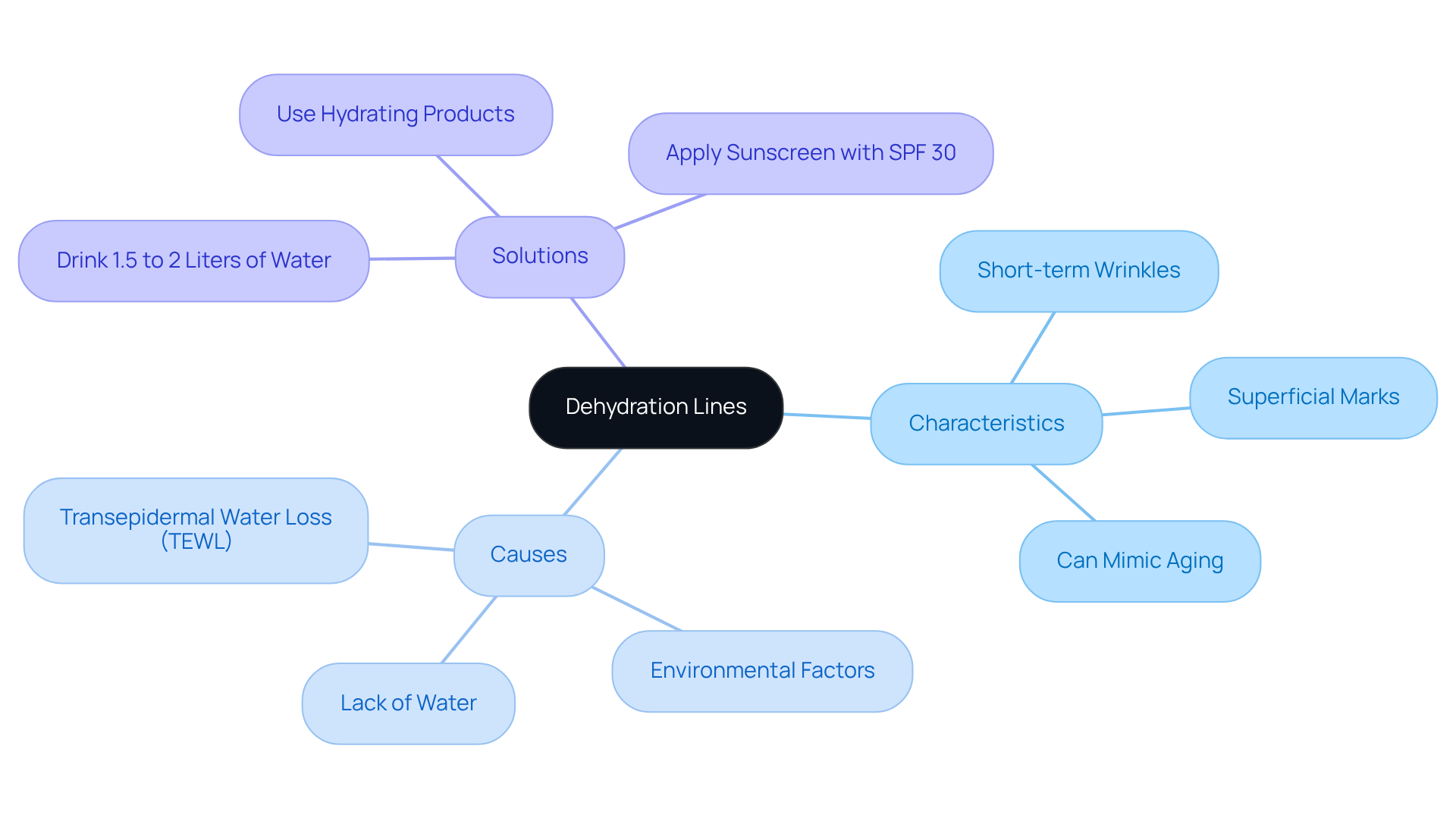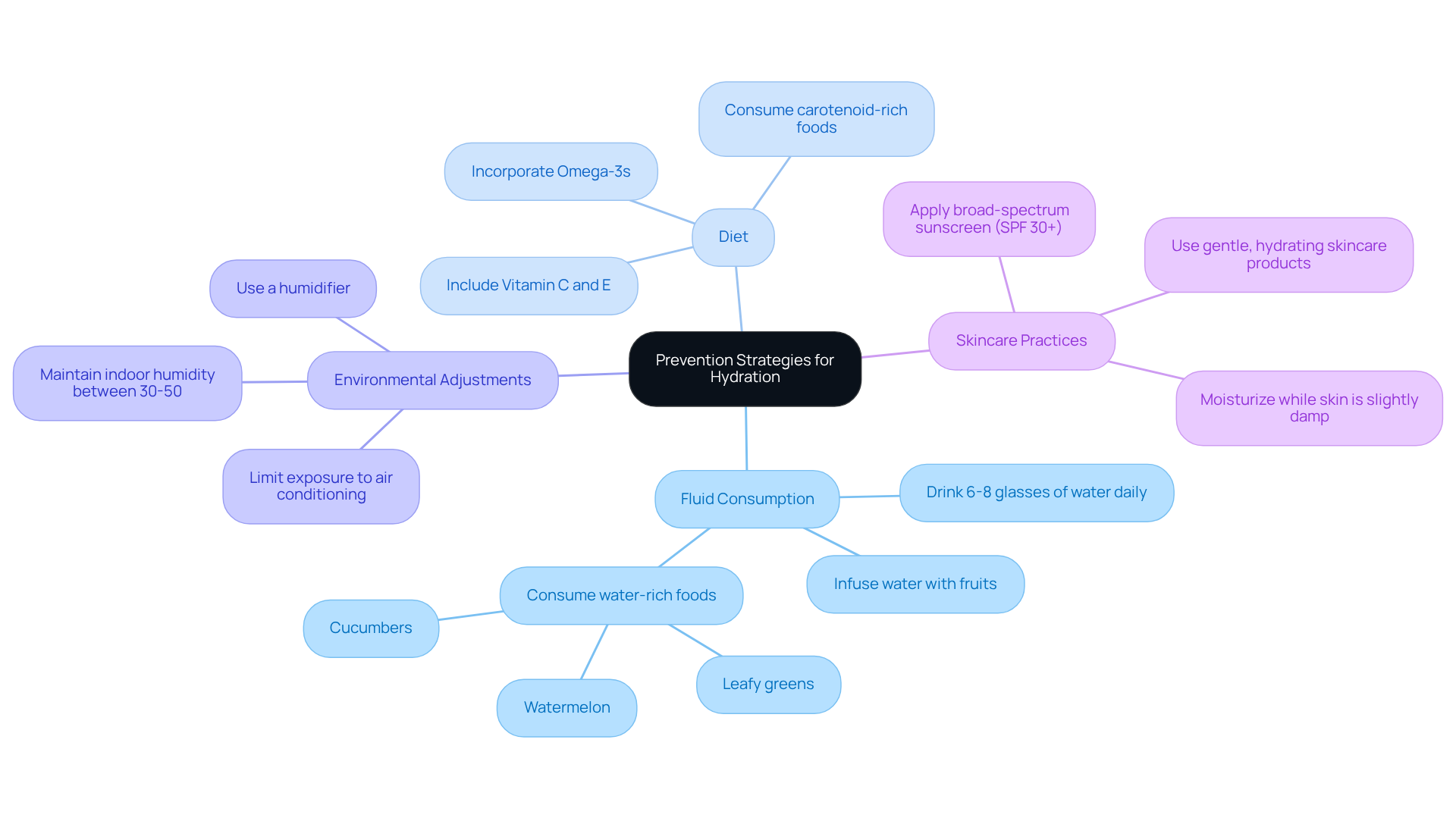Combat Dehydration Lines on Forehead: Causes, Treatments, and Prevention

Overview
Dehydration lines on the forehead arise from insufficient moisture in the skin, a condition often worsened by environmental factors and lifestyle choices. These superficial wrinkles can significantly detract from a youthful appearance. To combat this issue, it is crucial to maintain hydration through:
- Adequate water intake
- The use of hydrating skincare products
- Protection from harsh elements
Implementing these essential strategies is not merely advisable; it is imperative for effectively preventing and treating dehydration lines. By prioritizing hydration, individuals can enhance their skin's appearance and overall health. Therefore, make a commitment to your skin's hydration today—your future self will thank you.
Introduction
Dehydration lines on the forehead serve as an unwelcome reminder of the skin's pressing need for moisture, manifesting as subtle creases that detract from a youthful appearance. Understanding the causes and characteristics of these lines not only highlights the importance of hydration but also presents an opportunity to restore skin vitality through targeted treatments and preventive measures.
With various internal and external factors contributing to moisture loss, it becomes imperative to explore effective strategies to combat these pesky lines. How can one maintain a radiant complexion in the face of such challenges?
Define Dehydration Lines: Characteristics and Causes
Dehydration lines on forehead are subtle, short-term wrinkles that often appear on the forehead and around the eyes due to insufficient moisture in the skin's surface. Unlike deeper, more permanent creases, these marks are generally superficial and can easily be mistaken for early signs of aging. When the skin is dry or dehydrated, the dehydration lines on forehead become more pronounced, detracting from a youthful appearance. Conversely, a hydrated complexion appears plump and resilient, contributing to a more vibrant look.
The primary cause of moisture loss is the lack of water in the epidermis, which can be exacerbated by various environmental factors, including low humidity, excessive sun exposure, and the use of harsh skincare products. Increased transepidermal water loss (TEWL) occurs when the skin's moisture barrier is compromised, worsening the situation. Dermatologists emphasize that while wrinkles are a natural part of the aging process, characterized by a decline in collagen and elastin, moisture deficiency leads to surface marks. As dermatologists assert, "dryness marks aren’t identical to wrinkles and they require a distinct approach." This distinction is crucial for effective skincare, as addressing moisture levels can significantly reduce the visibility of these creases.
To combat dehydration lines on forehead, it is vital to maintain optimal moisture levels through a combination of internal and external strategies. Aim to drink 1.5 to 2 liters of water daily to ensure proper hydration. Additionally, employing hydrating skincare products containing ingredients like hyaluronic acid and glycerin can help restore moisture levels and improve skin texture. It is also critical to apply sunscreen with a minimum of SPF 30 daily to protect the skin from UV rays, which can aggravate dryness. By understanding the characteristics and causes of dehydration marks, individuals can take proactive steps to address and prevent them, ensuring a healthier, more radiant complexion.

Identify Contributing Factors: Internal and External Influences
Dehydration lines on the forehead can emerge from a combination of internal and external factors, making it crucial to understand their origins. Internally, insufficient water intake and a poor diet are significant contributors. A diet lacking in fruits and vegetables deprives the body of vital nutrients necessary for maintaining moisture. Moreover, excessive consumption of caffeine and alcohol can exacerbate dehydration, as these substances possess diuretic effects that increase water loss. Notably, studies indicate that the outer layer of the body comprises roughly 70% water, underscoring the essential need for adequate moisture to preserve its elasticity and overall well-being. Therefore, it is advisable to consume at least 1.5 to 2 liters of water daily to effectively promote hydration within the body.
Externally, environmental factors significantly influence the moisture retention of the epidermis. Elements such as low humidity, pollution, and prolonged sun exposure can strip moisture from the skin's surface, resulting in dehydration lines on the forehead. Additionally, the use of harsh skincare products containing alcohol or sulfates can further compromise the skin barrier, worsening dehydration. It is imperative to shield the skin from these external aggressors. Identifying these contributing factors is essential for developing effective treatment and prevention strategies to address dehydration lines on the forehead. This includes adopting a balanced diet rich in water-dense foods and maintaining a consistent fluid intake routine. Furthermore, incorporating products with hyaluronic acid and polyglutamic acid can markedly enhance hydration, leading to a more radiant complexion.

Explore Treatment Options: Skincare Routines and Advanced Therapies
Effectively addressing dehydration lines on forehead demands a strategic combination of a consistent skincare routine and advanced therapies. Begin with a mild, hydrating cleanser that preserves the body's natural oils. Incorporate products rich in hyaluronic acid, a powerful ingredient known for its ability to retain moisture. Following this, a high-quality moisturizer containing ceramides and glycerin is essential for locking in hydration.
For those seeking advanced solutions, therapies such as microneedling offer significant benefits. This technique not only stimulates collagen production but also markedly enhances moisture levels. Research indicates that microneedling can improve hydration by up to 40%, making it an appealing option for individuals aiming to combat dryness and wrinkles. Additionally, red light therapy at Tsavo Wellness is recognized for its rejuvenating effects, promoting cellular repair and reducing inflammation throughout the body.
By consistently integrating these advanced therapies into your skincare regimen, you can achieve remarkable improvements in skin texture and significantly reduce the visibility of dehydration lines on forehead. Take action today to elevate your skincare routine and embrace a more hydrated, youthful appearance.

Implement Prevention Strategies: Hydration and Lifestyle Adjustments
Avoiding dehydration issues necessitates a proactive dedication to fluid consumption and conscious lifestyle decisions. Sufficient water consumption is vital; aim for six to eight glasses each day, as moisture is essential for maintaining skin elasticity and preventing dehydration lines on forehead. To enhance hydration levels further, incorporate water-rich foods such as cucumbers, watermelon, and leafy greens into your diet. In dry environments, a humidifier can significantly improve moisture levels by maintaining optimal humidity between 30% and 50%, which is crucial for dermal health.
Moreover, protect your skin from sun damage by applying a broad-spectrum sunscreen with SPF 30 or higher daily, regardless of the weather. It is also advisable to avoid harsh, drying skincare products; instead, opt for gentle, hydrating formulations that support your skin barrier. As Dr. Diane Berson emphasizes, "Keeping your skin hydrated (inside and out) is one of the most effective ways to preserve firmness, reduce the depth of wrinkles, and maintain that elusive lit-from-within glow." By implementing these strategies, you can effectively reduce the risk of dehydration lines on forehead and promote a healthier, more radiant complexion.

Conclusion
Dehydration lines on the forehead are not merely cosmetic concerns; they signify deeper issues related to skin health and hydration. Understanding their characteristics, causes, and effective treatments is essential for anyone aiming to maintain a youthful appearance and vibrant skin. By prioritizing hydration both internally and externally, individuals can significantly diminish these superficial wrinkles and enhance their overall skin texture.
Key strategies for combating dehydration lines include:
- Maintaining adequate water intake
- Adopting a balanced diet rich in hydrating foods
- Utilizing skincare products that promote moisture retention
Advanced therapies, such as microneedling and red light therapy, can also provide significant benefits in improving skin hydration and texture. Recognizing the internal and external factors contributing to dehydration is crucial for implementing effective treatment and prevention measures.
Ultimately, fostering a proactive approach to hydration and skincare can lead to healthier, more radiant skin. By integrating these practices into daily routines, individuals can not only combat dehydration lines on the forehead but also enhance their overall skin health. Embrace these strategies today to ensure a more youthful and luminous complexion for years to come.
Frequently Asked Questions
What are dehydration lines?
Dehydration lines are subtle, short-term wrinkles that appear on the forehead and around the eyes due to insufficient moisture in the skin's surface. They are generally superficial and can be mistaken for early signs of aging.
What causes dehydration lines on the forehead?
The primary cause of dehydration lines is moisture loss in the epidermis, which can be worsened by environmental factors such as low humidity, excessive sun exposure, and the use of harsh skincare products. Increased transepidermal water loss (TEWL) also contributes to the problem when the skin's moisture barrier is compromised.
How do dehydration lines differ from traditional wrinkles?
Dehydration lines are not identical to traditional wrinkles. While wrinkles are a natural part of aging caused by a decline in collagen and elastin, dehydration lines are primarily caused by moisture deficiency and require a distinct skincare approach.
How can I reduce the visibility of dehydration lines?
To reduce the visibility of dehydration lines, it is important to maintain optimal moisture levels by drinking 1.5 to 2 liters of water daily and using hydrating skincare products with ingredients like hyaluronic acid and glycerin. Additionally, applying sunscreen with at least SPF 30 daily can protect the skin from UV rays that may aggravate dryness.
What role does hydration play in skin appearance?
A hydrated complexion appears plump and resilient, contributing to a more vibrant look, while dry or dehydrated skin can make dehydration lines more pronounced, detracting from a youthful appearance.
What skincare strategies are recommended for preventing dehydration lines?
Recommended strategies include drinking adequate water, using hydrating skincare products, and applying sunscreen daily to protect against environmental factors that can lead to moisture loss.

